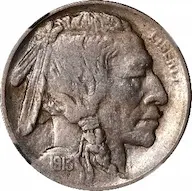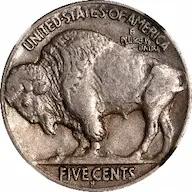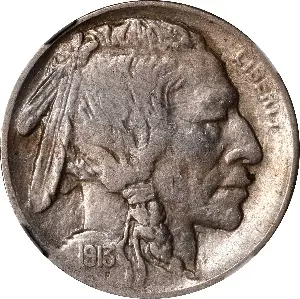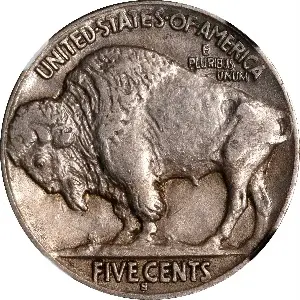1913-S Buffalo Nickel, Type 2
The Buffalo nickel design by James Earle Fraser was a highly acclaimed artistic masterpiece when it debuted in 1913. The obverse is dominated by the portrait of a resolute Native American, a composite of three real real-life models.(1)
The coin’s reverse depicted a bison (usually called a buffalo) facing left, inspired by Black Diamond, a longtime inhabitant of the Central Park Zoo in New York City.
While lobbying to convince Treasury Secretary Franklin MacVeigh to accept his design, Fraser wrote: “The idea of the Indian and the buffalo on the same coin is, without doubt, purely American and seems to be singularly appropriate to have on one of our national coins.”
Thankfully, for generations of collectors, MacVeigh agreed, and authorized production of the Buffalo nickel to move forward. The first releases of the new nickel entered circulation in early 1913.
Buffalo nickel output started out with a bang. Nearly 40 million(2) were struck during the first few months of the year. It didn’t take long to notice the wording FIVE CENTS, located on the rocky mound where the buffalo stood, was experiencing premature wear. Ditto for the mintmark.(3)
The Mint responded by placing the buffalo on a flat line, and creating a protective recessed area below called an exergue, where the denomination and mintmark were placed. This modification reduced the exposure of these important design elements.
Numismatists classify the variety with the buffalo on mound as Type 1. The flat line version is called Type 2. These are often labeled as Type I and Type II, respectively.
Many Type 1 Buffalo nickels were set aside by the public as a novelty when they first appeared. By the time Type 2 nickels hit the streets, few noticed, or seemed to care.(4)
Just 1.2 million Type 2 Buffalo nickels came out of the San Francisco Mint for the rest of the year. As the Buffalo nickel series gained in popularity with collectors during the 1950s and 1960s, it became evident there weren’t nearly enough 1913-S Type 2 examples to satisfy demand, resulting in steadily rising prices.
As has been true since then, the 1913-S Type 2 nickel has been recognized as a crucial key date in one of the most widely sought sets in United States numismatics.
Even an acclaimed coin like this one has been known to move in a yo-yo pricing manner. As of late, it has come close to scraping the floor, but if the past is any indicator, at some point the yo-yo will defy gravity and climb upward to new heights.
| Estimated survivors in all grades: 14,000 ?
The survivor estimate from PCGS represents an average of one or more experts' opinions as to how many examples survive of a particular coin in all grades. Survival estimates include coins that are raw, certified by PCGS, and certified by other grading services. Learn more at PCGS. |
| PCGS Rarity Scale: 2.9 ?
The 'PCGS CoinFacts Rarity Scale' assesses the relative rarity of all U.S. coins, based on estimated surviving examples. The scale runs from 1.0 to 10.0. The higher the number, the rarer the coin.
Learn more at PCGS. |
| Search for the 1913-S Buffalo Nickel, Type 2 on eBay** |
Preview of eBay selection:
 |
 |
| Trendline Avg = 7.80 | CLASSIC RARITY |
 |
 |
| Trendline Avg = 7.80 | CLASSIC RARITY |
Historic Value Trend Charts:
| Last updated 2-5-25 | Return to Key Date Coin List | |
| Compare to Common Date Coin of Same Type | ||
|
|
||
| Download Charts to Your Computer | ||
Sources
1. Taxay, Don. The U.S. Mint and Coinage. New York, NY: Sanford J. Durst Numismatic Publications, 1966.
2. Yeoman, R.S. and Garrett, Jeff, et al. A Guide Book of United States Coins, 75th ed. Pelham, AL: Whitman Publishing, 2021.
3. Heritage Auctions. 1913-S 5C Type Two. Apr 2014 Auction.
4. NGC. 1913 S TYPE 2 5C MS.
**Many very fine coin dealers sell on eBay. At any point in time, there may be over one million search results for United States coins. This includes quite a few of the recommendations on our Key Date Coin List.
If you’re thinking about purchasing a rare coin, eBay is certainly worth a look. For your convenience, the links from this site to eBay are coded to bring up only coins certified by PCGS and NGC.
As is always, always the case, never buy a valuable coin from a seller whose trustworthiness cannot be verified. Learn more about this at our chapter Best Places to Buy Coins, which also has a section on doing business on eBay.
In the interest of full disclosure, Rare Coins 101 receives a small commission anytime someone connects to eBay from this site and purchases something.
Coin images by Stack's Bowers Galleries.


